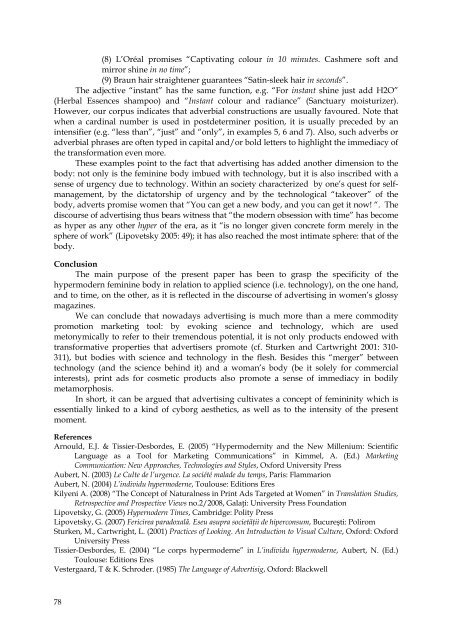Vol. 5/2009 - Facultatea de Litere
Vol. 5/2009 - Facultatea de Litere
Vol. 5/2009 - Facultatea de Litere
You also want an ePaper? Increase the reach of your titles
YUMPU automatically turns print PDFs into web optimized ePapers that Google loves.
(8) L’Oréal promises “Captivating colour in 10 minutes. Cashmere soft and<br />
mirror shine in no time”;<br />
(9) Braun hair straightener guarantees “Satin-sleek hair in seconds”.<br />
The adjective “instant” has the same function, e.g. “For instant shine just add H2O”<br />
(Herbal Essences shampoo) and “Instant colour and radiance” (Sanctuary moisturizer).<br />
However, our corpus indicates that adverbial constructions are usually favoured. Note that<br />
when a cardinal number is used in post<strong>de</strong>terminer position, it is usually prece<strong>de</strong>d by an<br />
intensifier (e.g. “less than”, “just” and “only”, in examples 5, 6 and 7). Also, such adverbs or<br />
adverbial phrases are often typed in capital and/or bold letters to highlight the immediacy of<br />
the transformation even more.<br />
These examples point to the fact that advertising has ad<strong>de</strong>d another dimension to the<br />
body: not only is the feminine body imbued with technology, but it is also inscribed with a<br />
sense of urgency due to technology. Within an society characterized by one’s quest for selfmanagement,<br />
by the dictatorship of urgency and by the technological “takeover” of the<br />
body, adverts promise women that “You can get a new body, and you can get it now! “. The<br />
discourse of advertising thus bears witness that “the mo<strong>de</strong>rn obsession with time” has become<br />
as hyper as any other hyper of the era, as it “is no longer given concrete form merely in the<br />
sphere of work” (Lipovetsky 2005: 49); it has also reached the most intimate sphere: that of the<br />
body.<br />
Conclusion<br />
The main purpose of the present paper has been to grasp the specificity of the<br />
hypermo<strong>de</strong>rn feminine body in relation to applied science (i.e. technology), on the one hand,<br />
and to time, on the other, as it is reflected in the discourse of advertising in women’s glossy<br />
magazines.<br />
We can conclu<strong>de</strong> that nowadays advertising is much more than a mere commodity<br />
promotion marketing tool: by evoking science and technology, which are used<br />
metonymically to refer to their tremendous potential, it is not only products endowed with<br />
transformative properties that advertisers promote (cf. Sturken and Cartwright 2001: 310-<br />
311), but bodies with science and technology in the flesh. Besi<strong>de</strong>s this “merger” between<br />
technology (and the science behind it) and a woman’s body (be it solely for commercial<br />
interests), print ads for cosmetic products also promote a sense of immediacy in bodily<br />
metamorphosis.<br />
In short, it can be argued that advertising cultivates a concept of femininity which is<br />
essentially linked to a kind of cyborg aesthetics, as well as to the intensity of the present<br />
moment.<br />
References<br />
Arnould, E.J. & Tissier-Desbor<strong>de</strong>s, E. (2005) “Hypermo<strong>de</strong>rnity and the New Millenium: Scientific<br />
Language as a Tool for Marketing Communications” in Kimmel, A. (Ed.) Marketing<br />
Communication: New Approaches, Technologies and Styles, Oxford University Press<br />
Aubert, N. (2003) Le Culte <strong>de</strong> l’urgence. La société mala<strong>de</strong> du temps, Paris: Flammarion<br />
Aubert, N. (2004) L’individu hypermo<strong>de</strong>rne, Toulouse: Editions Eres<br />
Kilyeni A. (2008) “The Concept of Naturalness in Print Ads Targeted at Women” in Translation Studies,<br />
Retrospective and Prospective Views no.2/2008, Galaţi: University Press Foundation<br />
Lipovetsky, G. (2005) Hyperno<strong>de</strong>rn Times, Cambridge: Polity Press<br />
Lipovetsky, G. (2007) Fericirea paradoxală. Eseu asupra societăţii <strong>de</strong> hiperconsum, Bucureşti: Polirom<br />
Sturken, M., Cartwright, L. (2001) Practices of Looking. An Introduction to Visual Culture, Oxford: Oxford<br />
University Press<br />
Tissier-Desbor<strong>de</strong>s, E. (2004) “Le corps hypermo<strong>de</strong>rne” in L’individu hypermo<strong>de</strong>rne, Aubert, N. (Ed.)<br />
Toulouse: Editions Eres<br />
Vestergaard, T & K. Schro<strong>de</strong>r. (1985) The Language of Advertisig, Oxford: Blackwell<br />
78












